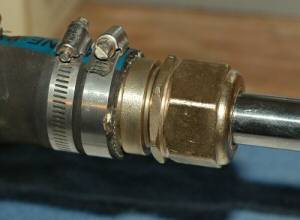The stuffing box is the last line of defense between the water and your engine room. It allows the shaft to be in two places at once – inside the boat and outside the boat – almost like magic!

What allows a stuffing box to work it’s magic is a wax coated (or newer-type) packing. Since water is needed to lubricate the shaft, it will slightly drip. If it did not, the wax would melt from the packing as the shaft creates heat from turning and the barrier would no longer work. It is not unusual to see the stuffing box drip at rest – don’t be concerned unless it is dripping non-stop (which is not actually a drip at that point). It is also not uncommon to have to readjust several time after repacking the stuffing box with new packing. Each time you tighten the stuffing box, it compresses the packing a bit more though. Over tightening the stuffing box will do two things. The first is to stop water lubrication, hence destroying the barrier. The second is to shorten the life of your packing and can even cut a groove in your shaft!
To adjust and install new packing special wrenches are needed. If you are at all boat-savy, you should have a set on board. All adjustments can be made with the boat in the water. Installing new packing can also be done in the water if you are not sqeamish about taking on a bit of water. This should only be done in an emergency though and with all bilge pumps working. In this case, you just put one more ring of packing in though, instead of pulling the old packing out. This will eliminate the massive amount of water coming in the boat.
You will know the stuffing box needs to be repacked when it requires frequent adjustment. When it is in good shape, you seldom need to touch it. When you start seeing more water in your bilges or hear the bilge pumps running a lot, check that first.
Alternatives
It is also possible to get “dripless” style stuffing boxes. These rely on different methods to keep the water out. This excerpt is from the PSS Shaft Seal web site:
 A mechanical seal is created by the contact of a turning surface against a stationary surface. In the case of the PSS Shaft Seal, the stationary surface is a carbon flange held in contact against a stainless steel rotor which turns with the shaft. The carbon flange is attached to the boat by a nitrile bellow which, with the help of water pressure, produces a constant contact between the carbon and the stainless steel ring. These type of seals are unaffected by engine motion or vibrations. The result is a 100% watertight and totally maintenance-free seal.
A mechanical seal is created by the contact of a turning surface against a stationary surface. In the case of the PSS Shaft Seal, the stationary surface is a carbon flange held in contact against a stainless steel rotor which turns with the shaft. The carbon flange is attached to the boat by a nitrile bellow which, with the help of water pressure, produces a constant contact between the carbon and the stainless steel ring. These type of seals are unaffected by engine motion or vibrations. The result is a 100% watertight and totally maintenance-free seal.
This is not the only company making this type of seal, but they all work using similar techniques. If you have older stuffing boxes, contact us for pricing on changing over to dripless seals.
Сувенири  What allows a stuffing box to work it’s magic is a wax coated (or newer-type) packing. Since water is needed to lubricate the shaft, it will slightly drip. If it did not, the wax would melt from the packing as the shaft creates heat from turning and the barrier would no longer work. It is not unusual to see the stuffing box drip at rest – don’t be concerned unless it is dripping non-stop (which is not actually a drip at that point). It is also not uncommon to have to readjust several time after repacking the stuffing box with new packing. Each time you tighten the stuffing box, it compresses the packing a bit more though. Over tightening the stuffing box will do two things. The first is to stop water lubrication, hence destroying the barrier. The second is to shorten the life of your packing and can even cut a groove in your shaft!
To adjust and install new packing special wrenches are needed. If you are at all boat-savy, you should have a set on board. All adjustments can be made with the boat in the water. Installing new packing can also be done in the water if you are not sqeamish about taking on a bit of water. This should only be done in an emergency though and with all bilge pumps working. In this case, you just put one more ring of packing in though, instead of pulling the old packing out. This will eliminate the massive amount of water coming in the boat.
You will know the stuffing box needs to be repacked when it requires frequent adjustment. When it is in good shape, you seldom need to touch it. When you start seeing more water in your bilges or hear the bilge pumps running a lot, check that first.
Alternatives
It is also possible to get “dripless” style stuffing boxes. These rely on different methods to keep the water out. This excerpt is from the PSS Shaft Seal web site:
What allows a stuffing box to work it’s magic is a wax coated (or newer-type) packing. Since water is needed to lubricate the shaft, it will slightly drip. If it did not, the wax would melt from the packing as the shaft creates heat from turning and the barrier would no longer work. It is not unusual to see the stuffing box drip at rest – don’t be concerned unless it is dripping non-stop (which is not actually a drip at that point). It is also not uncommon to have to readjust several time after repacking the stuffing box with new packing. Each time you tighten the stuffing box, it compresses the packing a bit more though. Over tightening the stuffing box will do two things. The first is to stop water lubrication, hence destroying the barrier. The second is to shorten the life of your packing and can even cut a groove in your shaft!
To adjust and install new packing special wrenches are needed. If you are at all boat-savy, you should have a set on board. All adjustments can be made with the boat in the water. Installing new packing can also be done in the water if you are not sqeamish about taking on a bit of water. This should only be done in an emergency though and with all bilge pumps working. In this case, you just put one more ring of packing in though, instead of pulling the old packing out. This will eliminate the massive amount of water coming in the boat.
You will know the stuffing box needs to be repacked when it requires frequent adjustment. When it is in good shape, you seldom need to touch it. When you start seeing more water in your bilges or hear the bilge pumps running a lot, check that first.
Alternatives
It is also possible to get “dripless” style stuffing boxes. These rely on different methods to keep the water out. This excerpt is from the PSS Shaft Seal web site:
 A mechanical seal is created by the contact of a turning surface against a stationary surface. In the case of the PSS Shaft Seal, the stationary surface is a carbon flange held in contact against a stainless steel rotor which turns with the shaft. The carbon flange is attached to the boat by a nitrile bellow which, with the help of water pressure, produces a constant contact between the carbon and the stainless steel ring. These type of seals are unaffected by engine motion or vibrations. The result is a 100% watertight and totally maintenance-free seal.
This is not the only company making this type of seal, but they all work using similar techniques. If you have older stuffing boxes, contact us for pricing on changing over to dripless seals.Сувенири
A mechanical seal is created by the contact of a turning surface against a stationary surface. In the case of the PSS Shaft Seal, the stationary surface is a carbon flange held in contact against a stainless steel rotor which turns with the shaft. The carbon flange is attached to the boat by a nitrile bellow which, with the help of water pressure, produces a constant contact between the carbon and the stainless steel ring. These type of seals are unaffected by engine motion or vibrations. The result is a 100% watertight and totally maintenance-free seal.
This is not the only company making this type of seal, but they all work using similar techniques. If you have older stuffing boxes, contact us for pricing on changing over to dripless seals.Сувенири 
